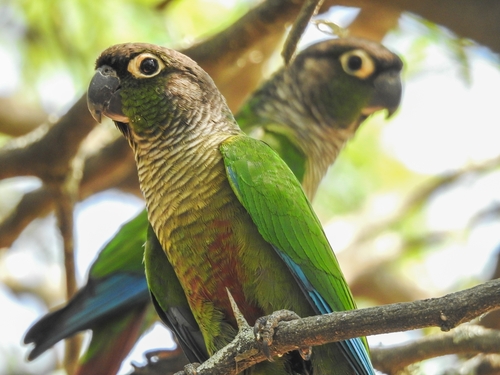
Green-cheeked Parakeet
The Green-cheeked Parakeet (Pyrrhura molinae), also known as the Green-cheeked Conure, is a small, vibrant parrot native to South America. It is renowned for its playful personality and relatively quiet nature compared to other conure species, making it a popular companion bird. Ecologically, it plays a role in seed dispersal within its native forests. While not currently facing major conservation concerns, habitat loss remains a potential long-term threat.
24-26 cm
Length
Not readily available cm
Wingspan
Least Concern
Conservation Status
Distribution
The Green-cheeked Parakeet is found in south-central South America, primarily in the countries of Brazil, Bolivia, Argentina, and Paraguay. Their range extends from Mato Grosso in Brazil to northern Argentina, encompassing various forest types.
Lifespan
10-15 years in the wild; up to 30 years in captivity with proper care.
Green-cheeked Parakeet's Habitat
Habitat Types
Humid forests, Dry forests, Woodlands, Savannas with scattered trees
Climate Zones
Tropical, Subtropical
Adaptations
Green-cheeked Parakeets have strong beaks adapted for cracking seeds and nuts, and their zygodactyl feet (two toes forward, two toes backward) provide excellent grip for climbing and manipulating food.
Variations
Several subspecies are recognized, differing slightly in plumage coloration and geographic location. These include *P. m. molinae*, *P. m. phoenicura*, *P. m. restricta*, *P. m. hypoxantha*, *P. m. australis* and *P. m. sordida*.
Appearance
Breeding Plumage
No significant difference between breeding and non-breeding plumage.
Seasonal Feather Changes
No major seasonal variations.
Sex Based Plumage Differences
Males and females are visually similar.
Notable Features
Predominantly green body plumage, Maroon tail feathers, Grayish-white eye rings, Dark gray beak, Green cheeks (hence the name)
Diet and Feeding
Primary Foods
Seeds, Fruits, Nuts, Berries, Vegetation, Occasional insects
Foraging Behavior
Green-cheeked Parakeets typically forage in flocks, moving through the forest canopy and sometimes descending to lower levels to feed. They use their beaks and feet to manipulate food items.
Specializations
Their strong beaks are well-suited for cracking open seeds and nuts, allowing them to access a wide range of food sources.
Seasonal Diet Variations
Their diet may vary slightly depending on the availability of fruits and seeds throughout the year. During periods of scarcity, they may rely more on nuts and seeds.
Behavior
Social Structure
Green-cheeked Parakeets are highly social birds and are often found in flocks of 10-20 individuals, or even larger aggregations outside of the breeding season.
Communication
Contact calls to maintain flock cohesion, Alarm calls to warn of danger, Softer vocalizations during social interactions
Migration
Generally non-migratory, although they may make local movements in response to food availability.
Territorial or Group Behaviors
During the breeding season, pairs become more territorial and defend their nesting site. Outside of breeding, they are generally gregarious.
Conservation
Threats
Habitat loss due to deforestation, Trapping for the pet trade (although less prevalent than for some other parrot species)
Protection Programs
CITES Appendix II (regulating international trade)
Local National Laws
Protected under various national and regional wildlife laws in their range countries.
Population Trend
Stable
Population Estimates
While a precise global population estimate is difficult, the species is considered relatively common within its range.
Interesting Facts
They are known for their relatively quiet vocalizations compared to other conures.
This makes them a popular choice for people who live in apartments or have close neighbors.
Green-cheeked Parakeets are highly intelligent and can learn tricks.
They are known for their problem-solving abilities and can be trained to perform various behaviors.
Several color mutations exist in captive-bred Green-cheeked Parakeets.
These include cinnamon, yellow-sided, pineapple, and turquoise variations.
Faqs about Green-cheeked Parakeet
Are Green-cheeked Parakeets good pets?
They can be excellent companions for the right owners. They are playful, affectionate, and relatively quiet, but they require daily interaction, a varied diet, and a stimulating environment.
How long do Green-cheeked Parakeets live?
In captivity, with proper care, they can live for up to 30 years, although 15-20 years is more typical.
Can Green-cheeked Parakeets talk?
They are not known for their extensive talking ability, but some individuals can learn a few words and phrases. They are better at mimicking sounds than forming complex sentences.
Copyright @ Nature Style Limited. All Rights Reserved.
 English
English